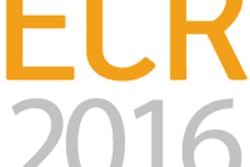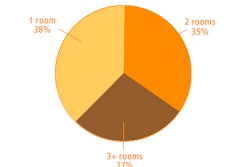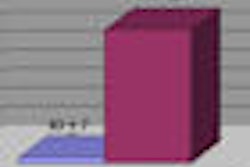For patients with nonspecific chest pain, whole-chest low-dose CT scans (also known as triple-rule-out studies) delivered better image quality and far lower radiation dose than comparable retrospectively gated scans, according to a new study in the American Journal of Roentgenology.
Results in the small series of emergency room patients suggest that the higher dose generated by traditional retrospectively gated CT exams may be hard to justify in most patients for detecting coronary artery stenosis and other diseases that can be diagnosed by extended z-axis coverage whole-chest exams.
Triple-rule-out scans are gaining popularity for their ability to quickly diagnose patients presenting with chest pain for three common etiologies: pulmonary embolism, coronary artery stenosis, and aortic dissection. But the technique's longer anatomic coverage requires a higher radiation dose, as much as 36 mSv, the group noted.
The use of prospective gating can reduce the dose via a patient table that moves in stepped increments triggered to the cardiac cycle. But the technique mostly has been explored for the shorter scan lengths used in cardiac imaging.
"We hypothesized that prospective [electrocardiogram (ECG)] triggering could result in substantial radiation dose reduction for long-z-axis whole-chest CT with maintenance of good coronary artery image quality similar to that of short-z-axis cardiac CT," wrote lead author Dr. William Shuman and colleagues from University of Washington School of Medicine in Seattle (AJR, June 2009, Vol. 192:6 pp. 1662-1667).
The study examined 72 consecutive patients with nonspecific chest pain using either retrospectively gated whole-chest CT angiography (CTA) (n = 41) or prospectively gated whole-chest CTA (n = 31). Patients were excluded for severe respiratory or cardiac failure, nonsinus rhythm, contraindication to iodinated contrast agents, pregnancy, or other common contraindications to cardiac CTA.
Patients arriving in the emergency department with a heart rate greater than 55 bpm were given an oral or intravenous beta-blocker, as well as a sublingual nitroglycerine spray before 64-detector-row CT (LightSpeed VCT XT, GE Healthcare, Chalfont St. Giles, U.K.) (The research was funded in part by a grant from GE.)
The researchers used a timed bolus to determine circulation time from the antecubital fossa to the aortic root. Then a dual-head power injector (Stellant D, Medrad, Warrendale, PA) was used to deliver a long three-phase bolus to opacify the pulmonary arteries, coronary arteries, and thoracic aorta at the same time during the scanning interval, using 70 mL of iodixanol contrast followed by 50 mL of a 70/30% blend of iodixanol and saline solution, and 50 mL of saline solution, all injected at 5 mL per second.
Patients were scanned from the thoracic inlet to just below the heart at 64 x 0.625 mm over 6-8 heartbeats, using 100 kVp, or 120 kVp for patients weighing more than 180 lb, and a reconstruction slice thickness of 0.625 mm and a 24-cm field-of-view.
Retrospectively gated images were first constructed at 75% of the RR interval, then at 0-90% in 10% increments through the heart to include both systole and diastole. Prospectively gated images were reconstructed at 60% to 80% of the RR interval in 5% increments. Tube current ranged from 600-790 mAs for retrospectively gated exams to 400-500 mAs for prospectively gated exams. All studies were examined on a dedicated 3D workstation (Advantage Windows 4.4, GE Healthcare).
Radiation doses were compared using unpaired Student's t-tests. Two experienced readers blinded to the scan technique independently scored the quality of images of the coronary arteries on a four-point Likert scale (1 being the best), comparing the scores by use of ordinal logistic regression.
The researchers found no significant difference in age, heart rate, body mass index, or z-axis coverage between the two groups of patients. However, the radiation dose was 71% lower in the prospective gating group. The mean effective radiation dose for retrospectively gated scans was 31.8 ± 5.1 mSv, compared with 9.2 ± 2.2 mSv (p < 0.001) for prospective gating. Two of 512 segments (0.4%) imaged with retrospective gating were nonevaluable, versus two of 394 segments (0.5%) imaged with prospective triggering.
"For all patients, individual segment images obtained with prospective triggering were 2.2 times as likely as images of the corresponding segment obtained with retrospective gating to have a higher quality score (95% CI, 1.1-4.5 times; p ≤ 0.05)," Shuman and colleagues wrote.
Lower dose
With respect to radiation dose, the researchers found that triple-rule-out with prospective gating delivered a 71% dose reduction compared with retrospective gating, the authors wrote.
An important limitation of prospective ECG triggering is the off-beam table-motion time of approximately one second during alternate heartbeats, which limits the technique to patients with heartbeats less than 75 bpm. Second, inasmuch as prospective triggering examines the heart during a small portion of the RR interval, functional information about cardiac valves, wall motion, wall thickening, and ejection fraction is not available with prospective triggering.
In addition, the scoring of image quality on a Likert scale is inherently subjective; however, good kappa values for interobserver agreement suggest reproducibility in the study, Shuman and colleagues wrote. In addition, contrast opacification was not compared across studies and exam techniques.
"We conclude that for whole-chest 64-MDCT of emergency department patients with nonspecific chest pain, prospective ECG triggering may result in substantially lower patient radiation dose and better coronary artery image quality than does retrospective ECG gating," Shuman and colleagues wrote.
However, the researchers added, the benefits of prospective triggering must be weighed against the inability to image patients with heart rates greater than 75 bpm, and the lack of functional information available with the technique.
By Eric Barnes
AuntMinnie.com staff writer
May 28, 2009
Related Reading
Wide-area CT detectors boost some clinical applications, May 20, 2009
SCCT publishes cardiac CTA guidelines, May 7, 2009
Tube current modulation cuts triple rule-out CTA dose, April 15, 2009
CT protocols reduce risk for pulmonary embolism, March 9, 2009
320-detector-row CT cuts dose in triple rule-out exams, February 12, 2009
Copyright © 2009 AuntMinnie.com



















